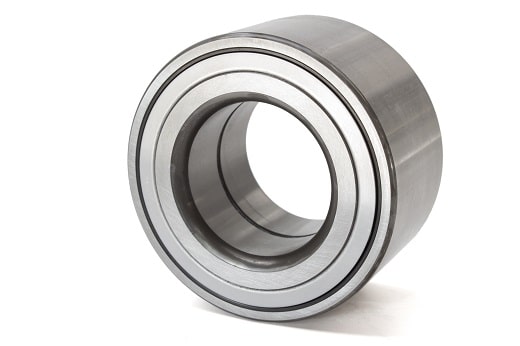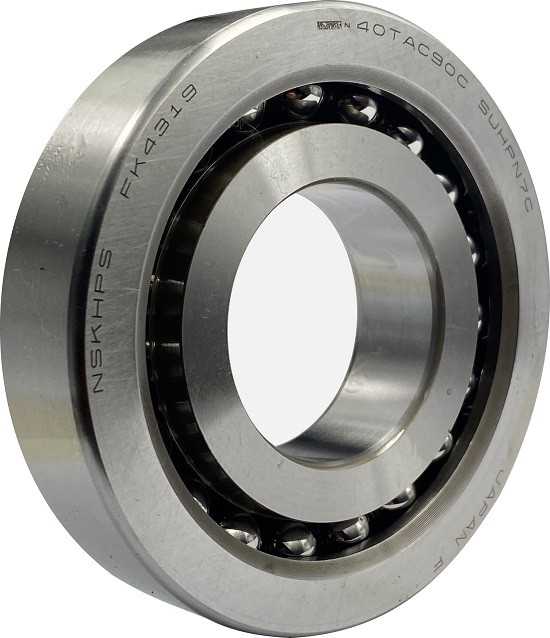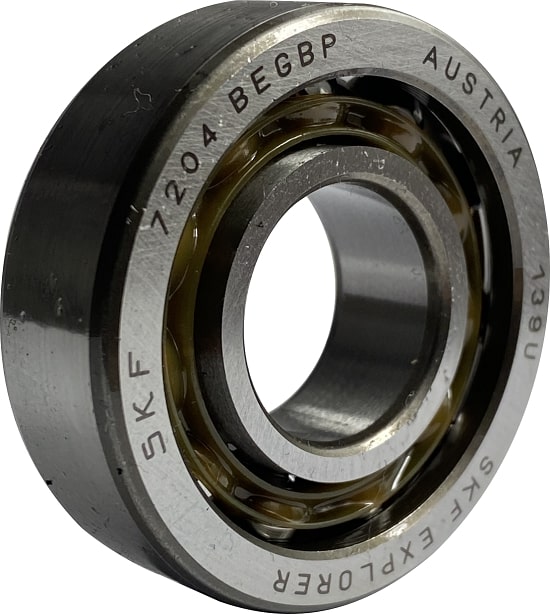Angular contact ball bearing
Startseite » Rolling bearings » Angular contact ball bearings
In angular contact ball bearings, the forces are transmitted from one groove to the other at a specific contact angle. For this reason, they are optimally suited for radial and axial loads acting simultaneously. Angular contact ball bearings have contact points in the inner and outer ring that are offset from each other, which defines the contact angle, also called the contact angle. The axial load carrying capacity of angular contact ball bearings increases with the size of the contact angle.
Compared to deep groove ball bearings, their bearing cross-section is asymmetrical. This enables the angular contact ball bearings to absorb forces whose line of action is not exactly perpendicular to the axis, but is at an angle to the perpendicular axes. This means that loads acting at an angle can be absorbed better. If you divide oblique loads into their radial and axial force components, angular contact ball bearings can only support axial loads in one direction. This type of bearing can be used universally in many applications and is installed specifically in machine tools, among others.
Angular contact ball bearings are available in a variety of designs and sizes. However, single-row angular contact ball bearings, double-row angular contact ball bearings, four-point contact bearings and single-row or double-row axial angular contact ball bearings are the most common angular contact ball bearings.
Single-row angular contact ball bearings
Single row angular contact ball bearings support axial loads in one direction only and must be adjusted against another bearing, usually another angular contact ball bearing, to support the opposing forces. They are available in two designs for different purposes. On the one hand as universal bearings for set installation, on the other hand as bearings of the basic design for bearing arrangements with single bearings. Single-row angular contact ball bearings of the basic design are used for bearing arrangements in which only one bearing is used per bearing position. Therefore they cannot be used for mounting in sets. Mounting in sets is selected if the respective load carrying capacity of a single angular contact ball bearing is not sufficient or if the bearing arrangement must support combined or axial loads in both directions with a certain axial clearance. A preferred application for single-row angular contact ball bearings is the bearing support of pumps. When mounted in sets, on the other hand, very high running accuracies and great rigidity can be achieved with precision angular contact ball bearings. For this reason, these bearings are often used in the bearing arrangements of machine tool spindles.
Pairing angular contact ball bearings
In practice, two angular contact ball bearings are often paired together, which means that axial forces acting on the bearings can run in two different directions (X or O arrangement) or a greater load can be supported in one axial direction (tandem arrangement):
Bearing sets in O arrangement
The pairing of angular contact ball bearings in an O-arrangement enables them to support high radial loads as well as axial forces from both directions.
Bearing sets in X arrangement
Angular contact ball bearings in X arrangement can support high radial loads and axial forces running in both directions (just as in O arrangement). The difference is the smaller span between the load application points. Thus, the load directions intersect on the shaft axis. In addition, the X arrangement has a lower tilt stiffness than the O arrangement, which is why higher skew positions are possible. For this reason, the X arrangement is particularly suitable for bearing arrangements in which shaft deflection is present.
Bearing sets in tandem arrangement
In some bearing cases, a simple O or X arrangement is not enough. In such a case, one or two bearings are added to the arrangement. In contrast to simple arrangements, such tandem arrangements can support higher axial forces in one direction.
Double row angular contact ball bearings
Double row angular contact ball bearings can support high radial and axial loads in both directions. The advantages of the double-row design include the smaller width and higher rigidity. This enables them to provide rigid bearing arrangements that can also accommodate tilting moments.

Four-point contact bearings
Four-point contact bearings are single-row angular contact ball bearings whose grooves are designed as “Gothic arches” so that they can support axial loads in both directions. Radial loads, however, can only be accommodated up to a portion of the axial load. Four-point bearings have the advantage that they are significantly narrower than double-row bearings.
Axial angular contact ball bearings
Axial angular contact ball bearings are mainly used in screw drives that are used to support the feed axes of machine tools.

PACH Systems offers you a wide product range of different angular contact ball bearings. For this purpose, we work together with our long-standing partners. Please let us know your requirements via our contact form. We will be happy to provide you with a non-binding offer or contact you to discuss the details.



